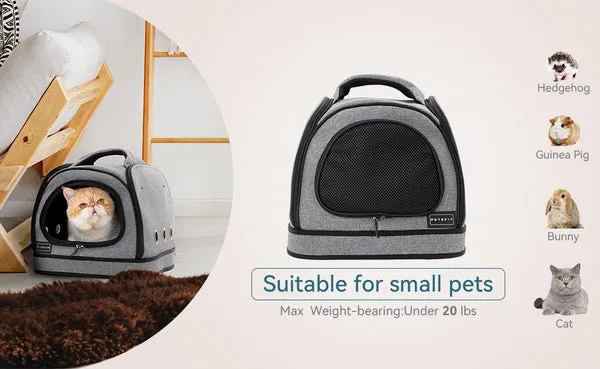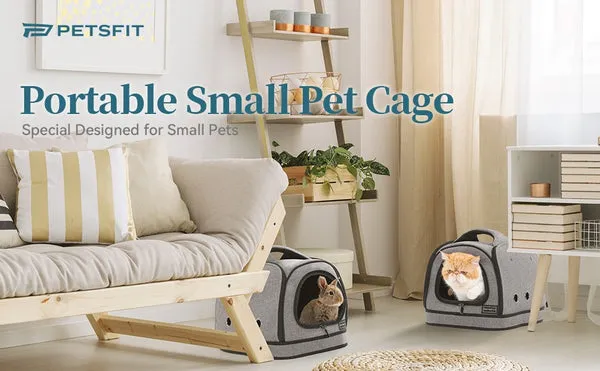Bringing a small dog, cat, or even a rabbit into your home is an exciting experience, and ensuring their comfort, safety, and well-being is paramount. One essential item every pet owner considers is a suitable cage or carrier. When searching for “Small Dog Cages For Sale,” you’re not just looking for a confinement tool, but a secure den, a safe travel companion, and a training aid. Modern pet carriers have evolved significantly, moving beyond rigid, often intimidating structures to embrace more pet-friendly, versatile designs. This guide will walk you through what makes a great small pet cage, focusing on the benefits of soft-sided options that offer superior comfort and convenience for both you and your furry friend. For more essential gear, explore the best website for dog accessories.
Why Do Small Dogs Need Cages? More Than Just Confinement
The term “cage” can sometimes carry a negative connotation, but for many small dogs and other pets, a properly introduced cage becomes a personal sanctuary. It serves multiple crucial roles:
Safety and Security at Home
A cage can provide a safe space for your dog when you’re unable to supervise them, preventing them from chewing on dangerous items or getting into mischief. It’s particularly useful for puppies during house-training or for dogs prone to anxiety, offering them a quiet retreat.
Travel and Vet Visits
Whether it’s a short trip to the vet, a cross-country adventure, or simply a visit to a friend’s house, a travel crate ensures your pet’s safety and containment. It prevents distractions while driving and keeps them secure in unfamiliar environments.
Potty Training and Behavioral Management
Crate training is a highly effective method for potty training puppies, as dogs naturally avoid soiling their sleeping area. It also helps manage behavior, providing a consistent routine and a quiet space for your dog to calm down.
A Private Den
Dogs are den animals by nature, and a cage, when properly introduced and made comfortable, can become their personal, cozy den where they feel safe and secure.
Soft-Sided vs. Hard-Sided: Understanding Your Options
When you’re browsing small dog cages for sale, you’ll encounter two primary types: hard-sided and soft-sided carriers. While hard-sided carriers offer rigid protection, soft-sided options have emerged as a more popular choice for small pets due to their distinct advantages.
Soft-sided carriers, like many modern designs, are crafted from flexible, durable fabrics. They are often lighter, making them easier to carry, especially during travel. Unlike hard-sided carriers, which can feel cold and stark, the soft material provides a more inviting and comfortable environment for your pet, reducing stress during transport. Their inherent flexibility also means they can often be collapsed for easy storage, taking up minimal space when not in use. This portability and comfort make them an excellent choice for pets weighing up to 20 lbs, including small dogs, cats, and rabbits.
 Soft-sided small dog cage for sale, showing a cat comfortably inside a portable pet carrier
Soft-sided small dog cage for sale, showing a cat comfortably inside a portable pet carrier
Key Features to Look For When Buying Small Dog Cages for Sale
When investing in a small dog cage, certain features can significantly enhance your pet’s comfort and your convenience.
Size and Fit
The most critical factor is ensuring the cage is the right size for your pet. A general rule of thumb is that your pet should be able to stand up, turn around, and lie down comfortably within the carrier. For items measuring around 16.3”x13.4”x11.8”, they are typically perfect for small dogs, cats, rabbits, guinea pigs, and similar sized animals weighing up to 20 lbs. Always measure your pet’s height and length before purchasing to guarantee a snug but comfortable fit.
Ease of Assembly and Storage
Look for designs that prioritize ease of use. A “one-zipper installation” feature means you can set up or collapse the carrier in mere seconds. This is invaluable for pet owners who frequently travel or have limited storage space. The ability to fold completely flat for storage ensures it won’t take up precious room in your car or home.
Ventilation and Visibility
Proper air circulation is vital for your pet’s health and comfort, especially during warmer weather or longer journeys. Carriers with mesh doorways in the front and multiple air holes on the sides ensure excellent ventilation. These mesh panels also provide visibility for your pet, allowing them to see their surroundings, which can reduce anxiety. For timid pets or those new to travel, the semi-concealed nature of soft-sided carriers can also offer a sense of security, helping to reduce panic.
Safety and Durability
A pet carrier must be secure. Features like a self-locking zipper head on the crate body prevent your pet from escaping, offering peace of mind that is not always guaranteed with potentially fragile hard-sided latches. The material quality is also crucial. Durable Oxford fabric for the main body and a front door mesh that is soft yet resistant to scratches from your pet’s nose and claws ensures longevity and safety.
Comfort and Cleanliness
Your pet’s comfort should be a top priority. Soft-sided materials are inherently more welcoming than rigid plastic. Additionally, a removable and washable fleece mat cover is a significant advantage, allowing for easy cleaning and maintaining a hygienic environment. This also helps contain pet hair, making cleanup simpler.
Portability
The lightweight nature of soft-sided dog cages makes them ideal for travel. Look for integrated handles or shoulder straps that make carrying your pet a breeze, whether you’re heading to the vet, taking a road trip, or enjoying a day out.
 Collapsible small dog cage for sale, featuring mesh ventilation and durable Oxford fabric
Collapsible small dog cage for sale, featuring mesh ventilation and durable Oxford fabric
Making the Most of Your Small Dog’s New Home
Once you’ve found the perfect small dog cage for sale, introducing it to your pet correctly is key to ensuring they love it.
Introduction to the Cage
Place the cage in a comfortable, quiet area of your home. Leave the door open and allow your pet to explore it at their own pace. You can entice them with treats or their favorite toys placed inside. Never force your pet into the cage; the goal is for them to associate it with positive experiences.
Making It Comfortable
Line the cage with a soft blanket or the provided fleece mat. You can also include a favorite toy or a piece of your clothing with your scent to make it feel more familiar and comforting. This transforms the cage from a mere container into a cozy den.
Using It for Travel
Before embarking on a long journey, let your pet spend short periods in the carrier at home. This helps them get accustomed to it. When traveling, always secure the carrier in your vehicle to prevent it from sliding, ensuring your pet’s safety. Make sure they have access to water and comfort breaks as needed.
Conclusion
Choosing the right small dog cage for sale is a decision that impacts your pet’s comfort, safety, and your peace of mind. While the market offers numerous options, soft-sided pet carriers stand out for their blend of comfort, portability, and user-friendly features. By considering factors like size, ease of assembly, ventilation, durability, and cleanliness, you can select a carrier that truly serves as a beneficial tool for training, travel, and providing a secure den for your beloved small pet. Always remember to prioritize your pet’s well-being and introduce any new cage gradually to ensure a positive experience.
